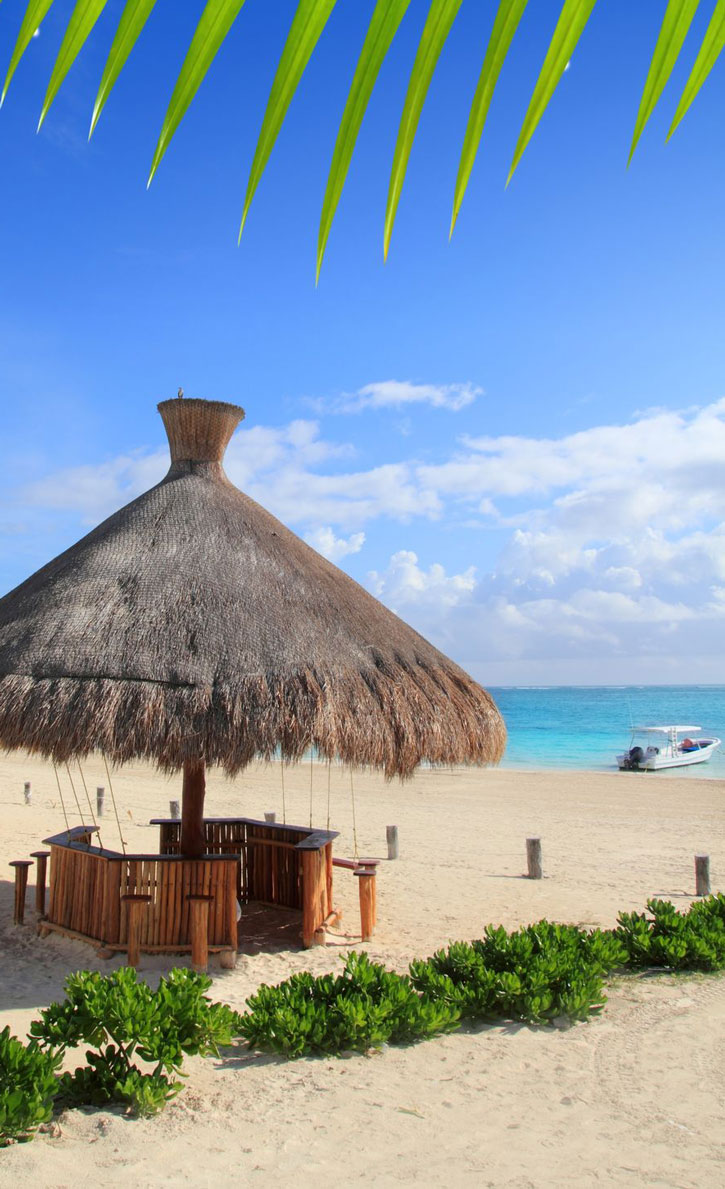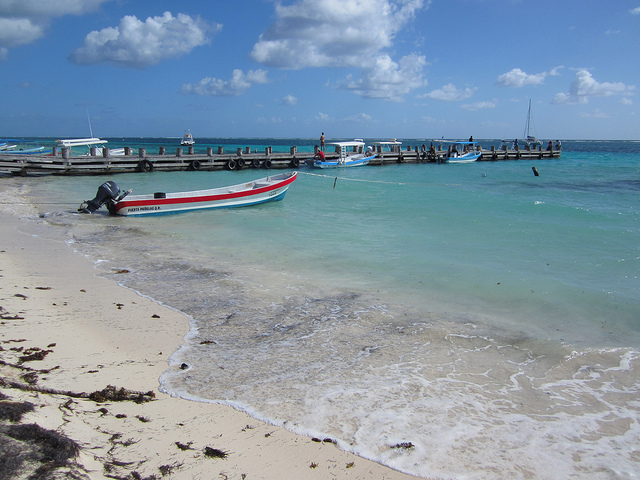Puerto Morelos improved its beachfront area considerably, with leafy arbors and however, lacks the creamy white sand found elsewhere in the Riviera Maya, and the same regulations that protect the town’s famous coral reef also prevent the removal of sea grass in the shallow areas. Fishing boats also moor on the beach, though there’s still plenty of room to lay out a towel. A good beach option is Club de Playa Los Pelícanos (central plaza, 9am-3pm Mon.-Sat.), which has lounge chairs, umbrellas, and kayaks. It’s located off one corner of the main plaza, in front of the restaurant of the same name.

Puerto Morelos, Quintana Roo. Photo © Tono Balaguer/123rf.
Puerto Morelos’s top attraction is snorkeling on the reef. Directly in front of the village, around 500 meters (0.3 mile) offshore, the reef here takes on gargantuan dimensions— up to 30 meters (99 feet) wide. Winding passages and large caverns alive with fish and sea flora make for great exploring. And since it’s a marine reserve, and fishing and motor traffic are limited, the reef is more pristine here than almost any place along the Riviera. A local cooperative (central plaza, Av. Rafaél Melgar s/n, no phone, 9am-3pm Mon.-Sat., US$25 pp for 2 hours) offers guided tours of the reef, with boats leaving every 30 minutes— or sooner, if there are four snorkelers—from the municipal pier.
Puerto Morelos’s peaceful central plaza has always been a highlight of the town, but a face-lift has made it even more appealing. New paint, better landscaping, and an improved play structure for kids make it a great place to while away the early evening hours, especially for families. Locals and visitors alike mingle on shaded benches and in the bleachers facing the basketball court. Many of Puerto Morelos’s best restaurants face the plaza or are just a block away, so you’re sure to pass by more than once. On Sunday, a small tianguis (flea market) is held here, and you can have fun browsing through someone else’s old treasures.
Marked by an enormous mustard-yellow arch on Highway 307, the “Cenote Route” is one of the newest developments along the Riviera Maya, and a sign, for better or worse, that the megaresorts are finally starting to appreciate cenotes. The route is simply a paved road, which begins just south of Puerto Morelos and extends nearly 20 kilometers (12.4 miles) into the scrub forest, passing several cenotes along the way. The most popular stops, at least for tour groups, are cenotes like Boca del Puma and Selvática, which also have ATV tours, ziplines, paintball—you get the picture. But the route also has some true gems: gorgeous and remote cenotes, undeveloped and all but overlooked by the package tours, and well worth the drive to reach them.
Independent travelers will particularly enjoy Siete Bocas (Carr. Pto. Morelos-Vallarta Km. 16, no phone, 8am-4pm daily, US$10 including life vest), so named for its seven openings (or “mouths”). Three openings have steep stairways leading straight into the cool, clear water; the other four allow sunlight into the underground chamber, lighting up the water dramatically, especially around midday. Inside, you can swim or float through the cave, with its spectacular stalagmites and stalactites, often with no one else around (BYO snorkel gear). Most visitors stay only a short time, but camping is permitted on-site (US$16 pp), just a few meters from the cenote.
Just down the road from Siete Bocas is Lucerno Verde (Carr. Pto. Morelos-Vallarta Km. 17, cell. tel. 998/224-3731, 8am-5pm daily, US$5 including life vest), an open-air cenote surrounded by huge tropical trees. Completely different from its neighbor but no less dramatic, Lucerno Verde is like an enormous swimming hole with clear turquoise water and seemingly no bottom. There’s a zipline as well as a thick safety line stretching across the cenote. Look for the freshwater turtles that make their home here. Camping is permitted here, too (US$10 pp).
A charming little tropical petting zoo, Croco Cun Zoo (Hwy. 307, tel. 998/850-3719, 9am-5pm daily, US$26 adult, US$16 child 6-12, free 5 and under) is located five kilometers (3.1 miles) north of the Puerto Morelos turnoff. Seventy-five-minute guided tours, offered in English or Spanish, bring visitors up close and personal to all sorts of local creatures. You can feed spider monkeys, walk through a crocodile enclosure, and hold boas, iguanas, and baby crocs. Well managed and reasonably affordable, Croco Cun is a hit for youngsters and adults alike.
Just south of the Puerto Morelos turnoff, a sprawling peaceful botanical garden, Ya’ax Ché Jardín Botánico (Hwy. 307 Km. 320, tel. 998/206-9233, 8am-4pm daily Nov.-Apr., 9am-5pm daily May-Oct., US$8.50 adult, US$4.25 child), has three kilometers (1.9 miles) of trails winding through diverse habitat, from tropical forest to mangrove swamp. In addition to hundreds of marked plants, there are remains of a Maya ruin and a re-creation of a modern Maya home. Monkeys can be sometimes spotted in the afternoon. Wear long sleeves and pants, and plenty of bug repellent.

The beaches of Puerto Morelos are dotted with sea grasses. The grass remains intact as part of a larger effort to preserve the offshore reef. Photo © Ken Marshall, licensed Creative Commons Attribution.
Excerpted from the Eleventh Edition of Moon Cancun & Cozumel.